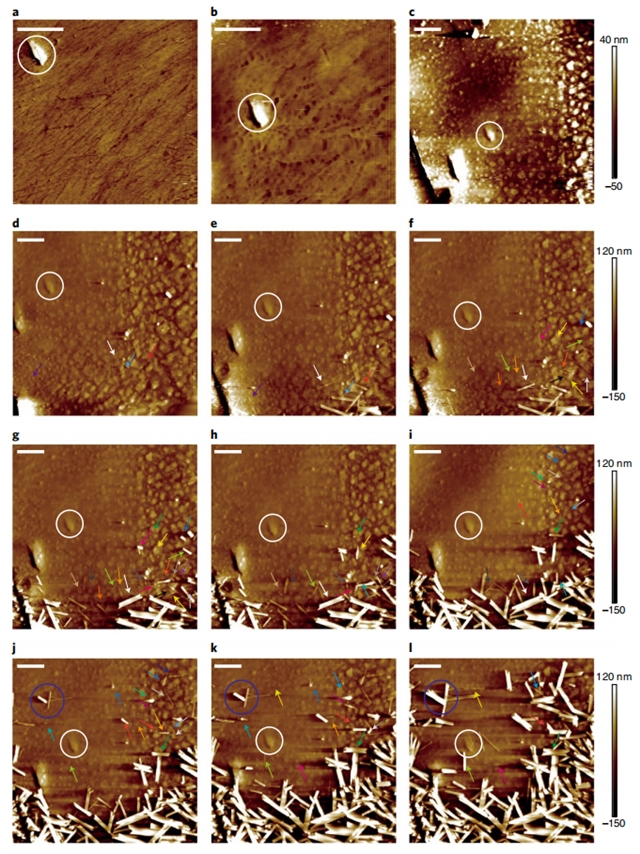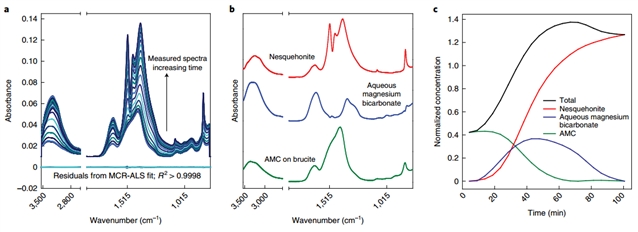|
|
|
|
|
高压原子力显微镜揭示二氧化碳封存过程中矿物碳酸盐化机制 |
|
|
北京时间2021年11月30日0时,美国西北太平洋国家实验室Xin Zhang、Herbert T. Schaef、Kevin M. Rosso研究团队在Nature Materials上发表一篇题为“In Situ Imaging of Brucite Carbonation in Supercritical CO2 Reveals an Amorphous Intermediate Seeding Crystallization”的研究。
研究团队通过使用自主研发的高压原子力显微镜(HP-AFM)揭示超临界二氧化碳流体地下封存过程中矿物碳酸盐化机制。该研究使用天然水镁石(氢氧化镁矿物)作为模型矿物。原位HP-AFM成像技术结合IR、X-ray PDF、XRD、XPS、SEM、TEM、TGA-MS、DFT模拟等工具展示了当该水镁石矿物暴露于水饱和的超临界二氧化碳时,其表面会迅速吸附水分子形成纳米级水团簇或者液膜并溶解形成大量纳米级蚀坑。随后溶解释放出的镁离子会和二氧化碳发生反应,形成无定型水合碳酸镁纳米颗粒。该无定形纳米颗粒进一步作为成核位点诱导形成更加稳定的结晶相三水合碳酸镁矿物。
第一作者是Xin Zhang研究员;论文通讯作者是Xin Zhang研究员、Herbert T. Schaef研究员,及Kevin M. Rosso研究员。
最近几十年,地球温度正在逐步上升,极端天气、两极冰架溶解、海平面上升等问题日益严峻。遏制气候变暖成为国际社会迫在眉睫的挑战。而二氧化碳作为最主要的温室效应气体,控制其在大气中的含量被认为是遏制气候变暖的关键。因此,“碳中和”应运而生并成为国际社会的焦点。
碳中和,是指国家、企业、产品、活动或个人在一定时间内直接或间接产生的二氧化碳排放总量,通过节能减排,捕捉封存等形式,自己抵消自己产生的排放量,实现正负抵消,达到相对“零排放”。在众多碳中和技术路线中,二氧化碳捕捉及矿物封存是降低大气二氧化碳浓度的最为有效及成本低廉的方法之一。二氧化碳矿物封存一般是将超临界二氧化碳注入深层地质结构中,通过一系列的化学反应(主要是CO2与含Mg和Ca的矿物发生反应)将二氧化碳转化成稳定的固体碳酸盐(主要是菱镁矿MgCO3和方解石CaCO3)将其进行长期封存。
CO2矿物封存技术的发展一定程度上依赖于我们对矿物碳酸盐化机制的理解。实际上,将CO2转化为稳定矿物是自然生物地球化学系统的重要过程,例如天然石灰岩的形成和生物矿化过程。借助各种原位技术,尤其是原位成像技术(包括AFM、TEM、SEM等),很多研究报道了普通大气压下矿物碳酸盐化机制。但高压环境下二氧化碳转化成稳定的固体碳酸盐的机制仍未清楚。
为了更好地理解这一过程,近日美国西北太平洋国家实验室Xin Zhang等研究人员通过使用自主研发的高压原子力显微镜来阐明天然矿物碳酸盐化机制。他们使用天然水镁石(brucite, Mg(OH)2)作为模型矿物。原位高压AFM实验表明水镁石不与无水超临界二氧化碳发生化学反应进行碳酸盐化。但是,在接触水饱和的超临界二氧化碳后,他们观察到水镁石迅速溶解并随后形成无定形碳酸镁(AMC)中间相且最终转化成更为稳定的结晶相三水合碳酸镁矿物nesquehonite (MgCO3•3H2O)。原位图像进一步显示 AMC 为三水合碳酸镁矿物的成核提供了种子。矿物结晶过程中,在化合物达到其最终的热力学有利状态之前普遍出现不稳定的中间相,但它们对后续相的影响尚不清楚。这项研究提供了一个直接证据,即无定形中间相通过引导产物微晶形成的位置影响随后的结晶结果。

Fig.1 Time-lapsed sequence of pressurized AFM images collected from a polished natural brucite surface during exposure to different scCO2 environments. a, AFM images after exposure to dry scCO2 60 min. b–l, AFM images after exposure to wet scCO2 (water saturated) after 65 (b), 276 (c), 355 (d), 362 (e), 366 (f), 370 (g), 375 (h), 379 (i), 384 (j), 388 (k) and 392 min (l). Experimental conditions: 90 bar wet scCO2, 50 °C and a flow rate of 250 µl min−1. Scale bar, 5 µm. Arrows with the same colour in e–l track the nucleation and crystal growth of isolated nesquehonite needles.
为了进一步揭示AMC的结构,研究人员使用原位红外、X-ray PDF、XRD、XPS、SEM、TEM、TGA-MS、DFT模拟等技术手段对其进行了深入研究。结果表明该AMC的化学分子式是MgCO3•xH2O (x= 0.5–1.0), 其结构与水菱镁矿 (Hydromagnesite)相似。

Fig. 2 AFM, SEM and TEM images of as-synthesized brucite nanodiscs and AMC. a,b, AFM (scale bar, 180 nm) (a) and SEM (scale bar, 200 nm) (b) images of brucite nanodiscs on silicon substrates. c,d, TEM images of a brucite nanodisc film on copper grid (c) after exposure to dry scCO2 for 60 min and the AMC product after exposure to wet scCO2 (water saturated) 180 min (d) (scale bar, 1 µm, in c,d). Experimental conditions: 90 bar, wet scCO2, 50 ℃ and a flow rate of 250 µl min−1.

Fig. 3 ATR-IR experimental results (90 bar scCO2, 50 ℃) on the powdered natural brucite. a, ATR-IR spectra collected as a function of time at an increment of ~5 minutes for a total of ~100 minutes at 93% RH from an IR titration of brucite with water. The arrows show the direction of increased absorbance with increasing time, although the OH stretching (3,260 cm−1) and HOH bending (1,640 cm−1) bands of water actually decreased in absorbance, beginning at ~65 minutes. A three-component MCR-ALS fit accounted for better than 99.98% of the variance, as demonstrated by the small residuals shown offset and below the measured spectra. b, The calculated spectral components assigned to nesquehonite, aqueous magnesium bicarbonate and AMC. c, The normalized concentrations of the components shown in b as a function of time, demonstrating the consumption of AMC (green), growth and consumption of aqueous bicarbonate (blue) and growth of nesquehonite (red).

Fig. 4 Structure of as-synthesized nanodisc brucite and AMC. a, Diffraction of brucite before (blue) and after (red) 24 hour reaction with 90 bar wet scCO2, 50 ℃ at a flow rate of 250 µl min−1. Dotted black lines denote baselines and highlight the increase in diffuse contributions between 1 and 5 Å−1, indicative of AMC. b, Experimentally determined PDF profile of AMC and calculated patterns for hydromagnesite (red), scaled to attenuate at 8.5 Å. Vertical dotted lines correspond to major features of the experimental PDF, specifically the C–O distance (1.28 Å), the Mg–O distance (2.09 Å), an O–O pair (3.07 Å) and a secondary Mg–O pair (4.15 Å).
除了了解二氧化碳封存过程中矿物碳酸盐化机制,阐明二价金属碳酸盐晶体的成核和生长机制对于理解生物地球化学过程(例如生物矿化)和改善工业应用(例如药物输送,能源存储等)也很重要。阐明其无定形前体的作用是理解金属碳酸盐结晶的一个重要方面。在许多天然和合成系统的结晶过程中会出现中间相,但它们对结晶结果的影响难以检测。该研究表明,结晶结果与中间体之间存在重要联系。(来源:科学网)
相关论文信息:https://doi.org/10.1038/s41563-021-01154-5